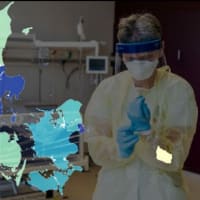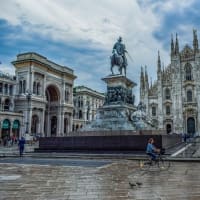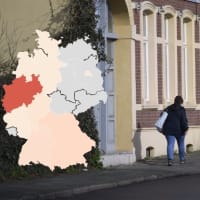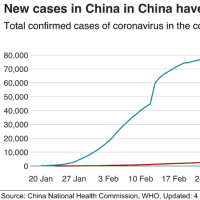2018年2月15日(Thu.) マイクロプラスティックに関する報道が続いています。 ( ニュースソース: DW-DE 2月14日発 )
<原文の一部>
Microplastic menace has spread to the world's most remote oceans
マイクロプラスティックの脅威は、世界の最も遠い海にまで広がっています。
New data collected in a round-the-world boat race has shown microplastics are in more of our planet's oceans than previously thought. What can we do to stop their spread?
世界一周のボート・レースで集められた新しいデータは、以前から考えられていたものより多くの地球上の海洋に、マイクロプラスティックが存在していることを示しています。 どうしたらこの拡散を止めることができるのでしょうか?

Participants currently taking part in a round-the-world ocean race encountered something surprising in the remote South Indian Ocean this month — a sea of microplastics.
Seven ships left Alicante, Spain, in October 2017 and are racing around the world, scheduled to finish in the Netherlands in June 2018. The Volvo Ocean Race has been taking place every three years since 1973, but this year one of she ships is quite different. Named 'Turn The Tide on Plastic,' it is collecting research about microplastics in the ocean along the way. And what it has collected so far is alarming to researchers.
As it left Spain and started it journey, its instruments detected a high degree of microplastics.
"That was not surprising, to see a higher number of microplastics close to the coast," Sören Gutekunst, the researcher who is analyzing the samples at the Geomar Helmholtz Centre for Ocean Research in the northern-German city of Kiel, told DW. "But then as it got into the Southern Indian Ocean, the increasing values were surprising."
(抜粋)世界一周のレースの参加者は今月(2月)、遠方の南インド洋で驚きのものに遭遇しました。 それはマイクロプラスティックの海です。
2017年10月、7隻の船がスペインを出発しました。 そして、世界を巡ってのレースをしています。 2018年の6月にはオランダでフィニッシュとなる計画です。 Volvo Ocean Race は1973年以来、3年毎に開催されているのですが、今年の1隻は全く異なるものです。 名前は'Turn The Tide on Plastic,'と言い、コースに沿った海洋にてマイクロプラスティックを収集調査するのです。 そして、これまでのところで収集されたものは、研究者たちに警告を発するものになっています。
旅の初めのスペインを出発した頃は、高レベルのマイクロプラスティックを装置が検出していました。 沿岸部でこうした高い数値を見ることは驚きではありませんでしたと研究者の一人が語っています。 しかし、南インド洋に入ってから、数値が上昇したことは驚きでしたと。

The ship detected microplastic particles at high volumes of 42 particles per cubic meter, at a latitude of 45.5 degrees south — further from land and deeper than they've ever been detected before. The findings suggest the microplastics are speading further and faster than previously thought.
(抜粋)南緯45.5度で、1㎥あたり42個の粒子を検出しました。 これまでに検出されたことのないような、陸地からも遠く離れ、深いところからなのです。 この発見が示すものは、以前から考えられていたことよりも、多く且つ速くマイクロプラスティックが拡散していると言うことです。
What are microplastics?
Microplastics are plastic particles smaller than 5 millimeters, either purposefully manufactured or the result of larger plastics breaking down. They are invisible to the human eye but end up in rivers and oceans, damaging the environment. These plastics are so small they can even enter our lungs through the air we breath, and our stomachs through the food we eat.
(抜粋)マイクロプラスティックとは? : これは5mm以下のプラスティック粒子を意味します。 元々そのように製造されたものや、大きな形状のものが砕けた結果でそうなったものも含まれます。 これらは人の目には見えないくらいのものですが、結果的に、川や海に辿りつき、環境に害を及ぼしているのです。 これらのプラスティックはとても小さくて、空気を呼吸することによって私達の肺に入りますし、食べ物を介して胃にも入っています。
Last month, the European Commission proposed a strategy to reduce their use in the European Union by making them subject to mandatory registration. The Commission is also looking into other options to reduce their use, such as mandatory labeling, minimum requirements for product design and durability, methods to assess quantities and pathways of microplastics in the environment, and funding for targeted research and innovation.
(抜粋)先月(1月)、欧州委員会はそれらのEUにおける使用を減らすための戦略を提示しました。 また、その他の項目についても調査しています。 例えば、ラベリングの義務化、設計上の最低限の要求事項や耐久性とか、評価方法、環境面での方針、そして、調査や改革のための資金手当てなどに関するものです。
The biggest problem with microplastics is that they remain such a mystery. Because they are invisible to the human eye and difficult to detect, not much testing has been carried out on them. The EU wants to determine how much plastic is out there in the environment, and whether it poses a health risk to humans who might ingest it.
(抜粋)最も大きな問題は謎がいまだに多いと言うことです(意訳)。 何故なら、それは人の目では見れなくて検出もできないからで、多くのテストができていないのです。 環境にどれぐらい存在しているか、また、人間が摂取することによって健康上のリスクがあるのかどうか等をEUは見定めたいたいと考えています。

"There is no conclusive evidence that they pose a threat to water supply, but we want to be on the safe side," said the Commission's First Vice President Frans Timmermans. "If it is established through monitoring that microplastics pose a threat, water suppliers will have to act and make sure they don't pollute tap water."
New data
Research on microplastics in oceans is still at a very early stage, with scientists currently able to identify only one percent of the plastic they believe is in the ocean. Because microplastics are so small, they are difficult to measure.
Gutekunst said the Turn The Tide on Plastic is the first ship in the Volvo Ocean Race to be collecting this data, which will bring new information about microplastics in these remote ocean regions.
"With this information we'll have more comparable data with one single system, we can compare the Indian Ocean to the Atlantic and the Pacific," he said. "This to my knowledge has never been done in such a short period of time with the same system."
The boats are currently racing from Hong Kong to New Zealand. From there they will sail across the Pacific to South America, and Gutekunst says he will be keenly watching to see if they come across the famous Pacific Garbage Patch.
"We will be in the Southern Pacific so we are far away from it," he said. "But there are currents that can take it very far, and there might be the possibility that we measure low values of microplastics in very remote areas."
Gutekunst hopes that by the time the boat pulls up in the Hague, it will have collected valuable information to combat the problem of plastic marine litter. While the Turn The Tide on Plastic is unlikely to win the boat race, it may help win the race to stop ocean pollution.
***
後半の和訳は略しますが、原文をサラリと読み流していただければ、今後の調査への期待などが示されています・・・。
それにしても、上に示された円グラフを是非ともご覧下さい。 35%は合成繊維の衣服などからで、28%はタイヤ、24%が都市ゴミ、7%が道路マーキング(道路標示など)、3.7%が船舶の防腐塗装・・・、などと示されており、驚愕の事実とも受け取れます。
一朝一夕に解決することは難しいかも知れませんが、発生源を抑えたり、河川や海洋への流入の阻止・回収するなどの対策も考案すべきなのかも知れません。
何れにしても、先ずは、こうした事実があることを周知すべきではないでしょうか。
*** 下の写真は、記事内容とは関係ありません。

***
<原文の一部>
Microplastic menace has spread to the world's most remote oceans
マイクロプラスティックの脅威は、世界の最も遠い海にまで広がっています。
New data collected in a round-the-world boat race has shown microplastics are in more of our planet's oceans than previously thought. What can we do to stop their spread?
世界一周のボート・レースで集められた新しいデータは、以前から考えられていたものより多くの地球上の海洋に、マイクロプラスティックが存在していることを示しています。 どうしたらこの拡散を止めることができるのでしょうか?

Participants currently taking part in a round-the-world ocean race encountered something surprising in the remote South Indian Ocean this month — a sea of microplastics.
Seven ships left Alicante, Spain, in October 2017 and are racing around the world, scheduled to finish in the Netherlands in June 2018. The Volvo Ocean Race has been taking place every three years since 1973, but this year one of she ships is quite different. Named 'Turn The Tide on Plastic,' it is collecting research about microplastics in the ocean along the way. And what it has collected so far is alarming to researchers.
As it left Spain and started it journey, its instruments detected a high degree of microplastics.
"That was not surprising, to see a higher number of microplastics close to the coast," Sören Gutekunst, the researcher who is analyzing the samples at the Geomar Helmholtz Centre for Ocean Research in the northern-German city of Kiel, told DW. "But then as it got into the Southern Indian Ocean, the increasing values were surprising."
(抜粋)世界一周のレースの参加者は今月(2月)、遠方の南インド洋で驚きのものに遭遇しました。 それはマイクロプラスティックの海です。
2017年10月、7隻の船がスペインを出発しました。 そして、世界を巡ってのレースをしています。 2018年の6月にはオランダでフィニッシュとなる計画です。 Volvo Ocean Race は1973年以来、3年毎に開催されているのですが、今年の1隻は全く異なるものです。 名前は'Turn The Tide on Plastic,'と言い、コースに沿った海洋にてマイクロプラスティックを収集調査するのです。 そして、これまでのところで収集されたものは、研究者たちに警告を発するものになっています。
旅の初めのスペインを出発した頃は、高レベルのマイクロプラスティックを装置が検出していました。 沿岸部でこうした高い数値を見ることは驚きではありませんでしたと研究者の一人が語っています。 しかし、南インド洋に入ってから、数値が上昇したことは驚きでしたと。

The ship detected microplastic particles at high volumes of 42 particles per cubic meter, at a latitude of 45.5 degrees south — further from land and deeper than they've ever been detected before. The findings suggest the microplastics are speading further and faster than previously thought.
(抜粋)南緯45.5度で、1㎥あたり42個の粒子を検出しました。 これまでに検出されたことのないような、陸地からも遠く離れ、深いところからなのです。 この発見が示すものは、以前から考えられていたことよりも、多く且つ速くマイクロプラスティックが拡散していると言うことです。
What are microplastics?
Microplastics are plastic particles smaller than 5 millimeters, either purposefully manufactured or the result of larger plastics breaking down. They are invisible to the human eye but end up in rivers and oceans, damaging the environment. These plastics are so small they can even enter our lungs through the air we breath, and our stomachs through the food we eat.
(抜粋)マイクロプラスティックとは? : これは5mm以下のプラスティック粒子を意味します。 元々そのように製造されたものや、大きな形状のものが砕けた結果でそうなったものも含まれます。 これらは人の目には見えないくらいのものですが、結果的に、川や海に辿りつき、環境に害を及ぼしているのです。 これらのプラスティックはとても小さくて、空気を呼吸することによって私達の肺に入りますし、食べ物を介して胃にも入っています。
Last month, the European Commission proposed a strategy to reduce their use in the European Union by making them subject to mandatory registration. The Commission is also looking into other options to reduce their use, such as mandatory labeling, minimum requirements for product design and durability, methods to assess quantities and pathways of microplastics in the environment, and funding for targeted research and innovation.
(抜粋)先月(1月)、欧州委員会はそれらのEUにおける使用を減らすための戦略を提示しました。 また、その他の項目についても調査しています。 例えば、ラベリングの義務化、設計上の最低限の要求事項や耐久性とか、評価方法、環境面での方針、そして、調査や改革のための資金手当てなどに関するものです。
The biggest problem with microplastics is that they remain such a mystery. Because they are invisible to the human eye and difficult to detect, not much testing has been carried out on them. The EU wants to determine how much plastic is out there in the environment, and whether it poses a health risk to humans who might ingest it.
(抜粋)最も大きな問題は謎がいまだに多いと言うことです(意訳)。 何故なら、それは人の目では見れなくて検出もできないからで、多くのテストができていないのです。 環境にどれぐらい存在しているか、また、人間が摂取することによって健康上のリスクがあるのかどうか等をEUは見定めたいたいと考えています。

"There is no conclusive evidence that they pose a threat to water supply, but we want to be on the safe side," said the Commission's First Vice President Frans Timmermans. "If it is established through monitoring that microplastics pose a threat, water suppliers will have to act and make sure they don't pollute tap water."
New data
Research on microplastics in oceans is still at a very early stage, with scientists currently able to identify only one percent of the plastic they believe is in the ocean. Because microplastics are so small, they are difficult to measure.
Gutekunst said the Turn The Tide on Plastic is the first ship in the Volvo Ocean Race to be collecting this data, which will bring new information about microplastics in these remote ocean regions.
"With this information we'll have more comparable data with one single system, we can compare the Indian Ocean to the Atlantic and the Pacific," he said. "This to my knowledge has never been done in such a short period of time with the same system."
The boats are currently racing from Hong Kong to New Zealand. From there they will sail across the Pacific to South America, and Gutekunst says he will be keenly watching to see if they come across the famous Pacific Garbage Patch.
"We will be in the Southern Pacific so we are far away from it," he said. "But there are currents that can take it very far, and there might be the possibility that we measure low values of microplastics in very remote areas."
Gutekunst hopes that by the time the boat pulls up in the Hague, it will have collected valuable information to combat the problem of plastic marine litter. While the Turn The Tide on Plastic is unlikely to win the boat race, it may help win the race to stop ocean pollution.
***
後半の和訳は略しますが、原文をサラリと読み流していただければ、今後の調査への期待などが示されています・・・。
それにしても、上に示された円グラフを是非ともご覧下さい。 35%は合成繊維の衣服などからで、28%はタイヤ、24%が都市ゴミ、7%が道路マーキング(道路標示など)、3.7%が船舶の防腐塗装・・・、などと示されており、驚愕の事実とも受け取れます。
一朝一夕に解決することは難しいかも知れませんが、発生源を抑えたり、河川や海洋への流入の阻止・回収するなどの対策も考案すべきなのかも知れません。
何れにしても、先ずは、こうした事実があることを周知すべきではないでしょうか。
*** 下の写真は、記事内容とは関係ありません。

***




















※コメント投稿者のブログIDはブログ作成者のみに通知されます